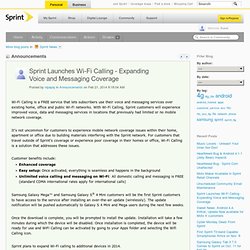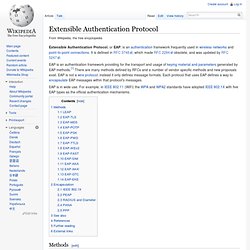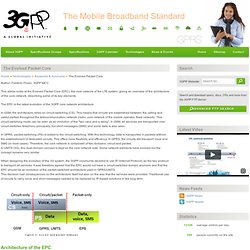

Community: Announcements: Sprint Launches Wi-Fi Calling - Expanding Voice and Messaging Coverage. Wi-Fi Calling is a FREE service that lets subscribers use their voice and messaging services over existing home, office and public Wi-Fi networks.

With Wi-Fi Calling, Sprint customers will experience improved voice, data and messaging services in locations that previously had limited or no mobile network coverage. It’s not uncommon for customers to experience mobile network coverage issues within their home, apartment or office due to building materials interfering with the Sprint network. For customers that travel outside of Sprint’s coverage or experience poor coverage in their homes or office, Wi-Fi Calling is a solution that addresses these issues. Customer benefits include: Enhanced coverageEasy setup: Once activated, everything is seamless and happens in the backgroundUnlimited voice calling and messaging on Wi-Fi: All domestic calling and messaging is FREE (standard CDMA international rates apply for international calls) Wi-Fi calls could be free on Sprint network. Opinion: VoWiFi offers bargaining power in the battle with WhatsApp Voice.
By John Hoadley, Chief Technology Officer of Taqua Ahead of the impending launch of WhatsApp Voice, Voice Over Wi-Fi (VoWiFi) offers communications service providers an opportunity to take the fight to the OTT messaging providers with improved user experiences.

While operators have been lamenting the loss of messaging revenues to OTT players for years, 2014 has seen the battle spread to voice like never before. Attendees at Mobile World Congress crowded to hear Mark Zuckerberg explain his plan to bring connectivity to every single person on the planet. While Zuckerberg offered partnerships and more profitable models to realise the Internet.org dream, WhatsApp’s Jan Koum revealed he would soon allow users to make voice calls on the app too. Operators now face stark choices. The WhatsApp voice announcement increases the competition on operators’ voice revenue stream.
As a result, operator strategies are changing to defend their revenue and find new opportunities in three ways. WP_Passpoint_Wi-Fi.pdf - Aurora. Extensible Authentication Protocol - Wikipedia, the free encyclopedia - Aurora. Extensible Authentication Protocol, or EAP, is an authentication framework frequently used in wireless networks and point-to-point connections.

It is defined in RFC 3748, which made RFC 2284 obsolete, and was updated by RFC 5247. EAP is in wide use. For example, in IEEE 802.11 (WiFi) the WPA and WPA2 standards have adopted IEEE 802.1X with five EAP types as the official authentication mechanisms. Methods[edit] EAP is an authentication framework, not a specific authentication mechanism.[1] It provides some common functions and negotiation of authentication methods called EAP methods.
The standard also describes the conditions under which the AAA key management requirements described in RFC 4962 can be satisfied. LEAP[edit] EAP-TLS[edit] EAP-Transport Layer Security (EAP-TLS), defined in RFC 5216, is an IETF open standard that uses the Transport Layer Security (TLS) protocol, and is well-supported among wireless vendors. EAP-MD5[edit] EAP-POTP[edit] The Evolved Packet Core. Author: Frédéric Firmin, 3GPP MCC This article looks at the Evolved Packet Core (EPC), the core network of the LTE system, giving an overview of the architecture of the core network, describing some of its key elements.

The EPC is the latest evolution of the 3GPP core network architecture. In GSM, the architecture relies on circuit-switching (CS). This means that circuits are established between the calling and called parties throughout the telecommunication network (radio, core network of the mobile operator, fixed network). This circuit-switching mode can be seen as an evolution of the "two cans and a string".
In GPRS, packet-switching (PS) is added to the circuit-switching. When designing the evolution of the 3G system, the 3GPP community decided to use IP (Internet Protocol) as the key protocol to transport all services. Architecture of the EPC EPC was first introduced by 3GPP in Release 8 of the standard. It was decided to have a "flat architecture". MAPCON2.jpg (JPEG Image, 886×946 pixels)
Multiple PDN.